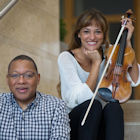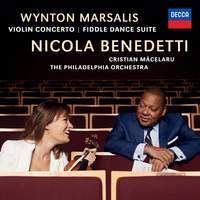Interview,
Nicola Benedetti on Wynton Marsalis
 Written for and premiered by Nicola Benedetti in 2015, Wynton Marsalis’s four-movement Violin Concerto is the jazz legend’s first full-length composition for violin and orchestra, and draws on ragtime, blues and Scottish folk music as well as numerous twentieth-century concertos. In the run-up to the release of its first recording on Decca earlier this month, I spoke to Nicola about her friendship with Wynton, how they worked together during the composition process, and the various classical and jazz influences at play in the work…
Written for and premiered by Nicola Benedetti in 2015, Wynton Marsalis’s four-movement Violin Concerto is the jazz legend’s first full-length composition for violin and orchestra, and draws on ragtime, blues and Scottish folk music as well as numerous twentieth-century concertos. In the run-up to the release of its first recording on Decca earlier this month, I spoke to Nicola about her friendship with Wynton, how they worked together during the composition process, and the various classical and jazz influences at play in the work…
How did you meet Wynton, and how long has the piece been in the works?
We met twelve or thirteen years ago, when I was playing at an event that was hosted by Jazz at Lincoln Center - I was one of 300 student delegates at a weekend of incredible activities that took place in America. It’s called the Academy of Achievement Summit, and it was one of the most life-changing weekends of my life. Over the years I attended many more of his concerts and Wynton continued to follow my career, as he always does with any young musician that he thinks shows promise and interest; he’d come and hear me play whenever he could, and I’d send him recordings. Then around five years ago I attended a performance of his Swing Symphony with Simon Rattle and the London Symphony Orchestra, and the environment that he created with that composition was one that I had never actually experienced in a concert-hall. I was there with several people who I work with and we all said that if we could get this person to write a violin concerto it would be such a phenomenal and unique addition to the genre, so we just set about asking! It took several years for him to actually agree to write a full-scale concerto, but obviously eventually he did, and then we set about putting together a group of commissioning orchestras.
How did the compositional process itself work – did you bat ideas back and forth whilst he was writing, or were you presented with a complete score and revise from there?
We communicated on each and every step along the way: we had a lot of discussion on what sort of form the piece would take, because obviously he’s adept and competent in writing in so many musical languages that there was the potential for it to develop in all kinds of different directions. We talked a lot about the structure and form, and as part of that process I sent the scores of various violin concertos for him to look at. Eventually he sent me the first draft of the violin part, which he wrote out like many composers do with the solo part and a piano ‘skeleton’, with harmonic and rhythmic sketches of the orchestral part and just notes as to which instruments he thought would do what, and then he expanded from that perspective.
Of those concerto scores which you sent him, which ones had the most impact on the piece?
In terms of the form, Shostakovich's Concerto No. 1 was quite an important study – I think that’s probably where the idea of having four movements and a cadenza joining one movement to another came from. And in terms of the technical aspects, I know he looked at the Brahms concerto a lot, as well as Bartók and Stravinsky.
I read in an interview which you gave shortly after the premiere that you asked for the writing to be made more difficult..?
Yes! I said that to him after he had sent me the first half of the first movement. My experience is in playing things that take a long time to study and a long time to learn, so something that I can sight-read just isn’t as interesting and challenging. Although Wynton’s been fascinated by the violin since he was young, and knows a lot about the instrument and has a really keen interest in it, there were obviously some technical things that he didn’t quite understand yet – but he’s such a diligent worker and is so serious about learning anything new that actually it didn’t take long for him to grasp what’s technically possible on the instrument and what isn’t.
Is the cadenza your own work?
No. The whole process was collaborative, but there’s nothing that I actually wrote myself – it’s all Wynton, including the cadenza.
You mentioned that Wynton has always kept abreast of your career and recordings: was there anything particular that he’d heard you play which set off trains of thought for him?
Oh, I’m sure there were many things: Wynton’s way is to write very personally for a particular musician, or even for a particular place, especially in his larger-scale compositions which take a huge amount of time and investment. So I think my sound was very much in mind while he was writing, particularly the fact that I have a certain way with playing slower melodies, and with more melodic or romantic music. Then there’s that ferocious, technically virtuosic element: lots of people tackle that kind of thing very differently when writing for the violin, but he definitely had my way of doing it in mind. And then obviously he took my own personality into account too – he knows me very well, so it was all connected!
Could you give me a brief overview of the genres and styles which the concerto encompasses?
I think it really represents Wynton and who he is, as well as the mixture of his personality and mine – my heritage, my influences and my relationship with the violin. The opening theme is very much in a melodic style that harks back to his Quintet, to big-band music that he’s composed, and to material that he’s written for himself to play: it’s romantic and it’s intimate, but with plenty of twists and turns along the way, and of course it’s all harmonically steeped in jazz and blues. And you wouldn’t have a composition of his without a Latin American influence: you’ll have a habanera in there, you’ll have 5/4 rhythms, and certain percussion textures from the Latin tradition. Then there are his European influences, which are so much more abstract and angular: it’s a more obtuse, angst-driven kind of sound that’s found in a great deal of late twentieth-century music, and that features quite a lot throughout the first movement where he uses a lot of major sevenths, and diminished and augmented intervals juxtaposed against each other.
If I were to categorise the second-movement Burlesque, I’d say it’s certainly Stravinsky-esque: this is almost parody-style music that’s very colourful and includes some extreme use of orchestration. The cadenza is a mix of many things, with Wynton taking inspiration from real blues musicians, particularly guitar-players – there’s a whole strumming section of that cadenza where I know he had Robert Johnson’s rhythmic obscurity and the unusual ways that he plays in mind. And the third movement is a blues in every respect: the way the chorus is formatted, the number of bars, the harmonic progressions. He takes you through all kinds of worlds through a chorus form: you start in an abstract world that’s inspired by Duke Ellington, then you go to a chorale format which has the strings singing and me responding through quasi-improvisation, then that leads into a blues shuffle, which I think is the most intimate moment in the concerto. The shuffle itself is played by the lower strings – they’re told to play in the style of Freddie Green, who was a guitar-player that had a really specific way of plucking. My part is very sensual and seductive (it took a lot of time for me to actually work out how to play this passage), and then you go straight from there into the church where I take the role of the preacher with the orchestra as the congregation. The movement ends with a lullaby, so there’s an almost dream-like sense of going back to childhood.
The last movement is a Hootenanny, which calls on Wynton’s own love of the Celtic traditions as well as my personal heritage, and also draws on the movement of Celtic music across the Atlantic through the migration of Scots people to America. That music culminates in a call and response section, which is a traditional jazz format: at the end of a virtuosic piece done with a jazz band, you would have a kind of play-off among different instruments where people would be showing off their versatility. In the Violin Concerto it plays out as the violinist showing off their various techniques, and the orchestra showing off all the different styles that they can play.
Was the solo Fiddle-Dance Suite written before or after the concerto?
In a sense it was both! Originally Wynton was only going to write a solo piece for me, because as you can imagine the time and investment involved in writing that is quite different from writing a concerto for full symphony orchestra, but then we managed to convince him to write the Violin Concerto, so it was a case of coming back to the original idea!
Did the pair of you ever play together while you were working on the project – or do you have plans to do so in the future?
No, I’m still trying to get him to play something with me, but I don’t think it’ll ever happen!
Nicola Benedetti (violin), Philadelphia Orchestra, Cristian Măcelaru
Available Formats: CD, MP3, FLAC, Hi-Res FLAC



